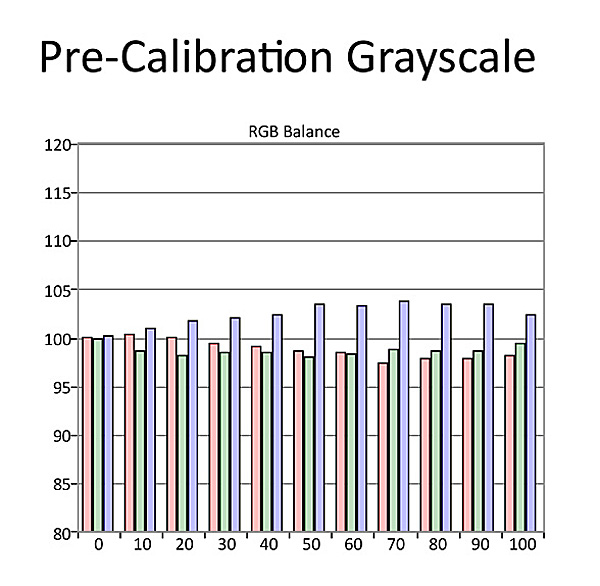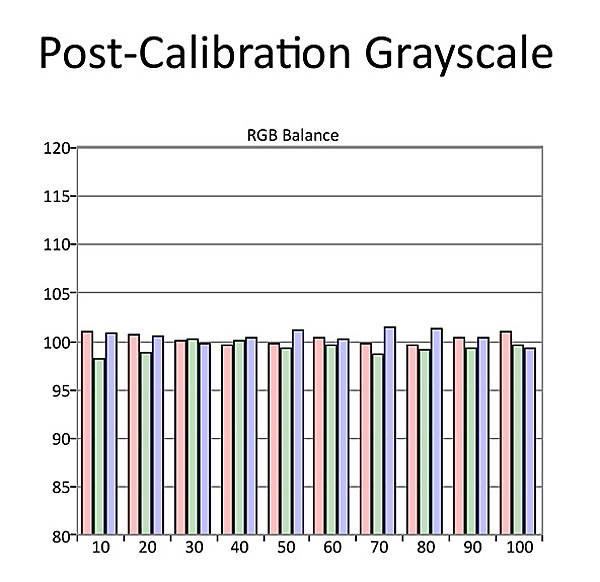Sony VPL-VW295ES 4K Video Projector Review Test Bench
(Some minor changes from the settings used for these calibrations were made in the final viewing tests.)
The measurements here were made using CalMAN measurement software from Spectracal, together with Photo Research PR-650 and Klein K-10A color meters and a test pattern generator from Murideo/AVPro (Fresco Six-G, for 4K/HDR).
The measurements were made at 15-feet from my 1.3 gain Stewart Studiotek 130 2.35:1 aspect ratio screen with the zoom set approximately to its midpoint. Both brightness and contrast will vary somewhat depending on the setting of the zoom control and, of course, the characteristics of the screen.


HD/SDR
Full-On/Full-Off Contrast Ratio: 4,500:1
In the Reference Calibrate preset, with the Brightness control at 54, Contrast at 80, Lamp setting at Low, Contrast Enhancer Off, and Gamma Correction at 2.4, the measured peak white level was 72 nits (21 foot-lamberts) and full black 0.016 nits (0.00467 ft-L).
In the (calibration adjusted) D65 Color Temp. mode with the above settings, the average pre-calibration grayscale Delta E from 10% to 100% was a maximum of 2.86 at 50%. Post-calibration, using only the 2-point grayscale controls, the maximum Delta E was 2.1 at 10%. The maximum color Delta E was 1.52 (magenta) before calibration and 1.96 (red and green) after. In the 2.4 setting the gamma ranged from 2.43 at 10% to 2.33 at 70% and 80%.
UHD/HDR
Full on/Full-off Contrast Ratio: 5,776:1
In the Cinema Film 2 Calibrated Preset, with the Brightness control at 72, Contrast at Max, the Lamp setting at High, and Contrast Enhancer on Low, the measured peak white level was 144.4 nits (42.1 foot-lamberts) and full black 0.025 nits (0.0073 ft-L). However, with HDR the bulk of the image falls below 50%, with the remainder theoretically reserved for highlights. The output at 50% measured 66 nits (19.3 ft-L), for a working contrast ratio over the brightness range encompassing the bulk of the program material of 66/0.025, or 2,640:1.
In the (calibration adjusted) Custom 5 Color Temp mode and the above settings, the post calibration grayscale Delta E peaked at 8.2 with luminance errors included (at 40%) and 1.3 without luminance errors included (at 60%). The color Delta E with ranged from a low of 0.3 (red) to a high of 7.3 (green). The range available from the CMS adjustments was not sufficient to generate better color Delta E results.
The HDR peak white output measured 141 nits +/- a maximum of 3 nits regardless of the size of the measured white window. The color saturation errors in BT.2020 were fair, slightly better in P3 (inside BT.2020), and very good in BT.709 (inside BT.2020). The middling BT.2020 and P3 results were mainly due to a wide deviation in green. This was not visually evident on real program material.
The Sony achieved 60.5% of BT.2020 (1976 standard) and 82.9% of P3 (1976 standard).
(Delta E is a figure of merit indicating how close the color comes to the grayscale and color standards at each point in the brightness range. Values below 3—some experts allow for 4—are generally considered visually indistinguishable from ideal.)




























































